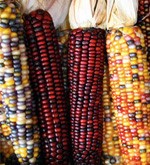Can Organic Garlic Seed Stock Be Created Disease-Free From the Production of Garlic Bulbils?
Serious diseases of garlic have been imported from foreign sources and are now widespread within the US and Canada. Stem and Bulb Nematode (Ditylenchus dipsaci) in garlic seed (vegetative reproduction) will infest the soil and is impossible to eradicate using organic approved methods. It is a threat to other crops, including onions, potatoes, alfalfa, and strawberries. Infested land is substantially reduced in value, as the nematode may be transferred on equipment.
 Maize (corn) is an incredibly productive and profitable crop that works well in organic crop rotations in many parts of North America. Since the release of transgenic (GMO) varieties of maize in the mid-1990s it has become increasingly difficult to grow uncontaminated organic maize or to find maize seed that is free of transgene contamination.
Maize (corn) is an incredibly productive and profitable crop that works well in organic crop rotations in many parts of North America. Since the release of transgenic (GMO) varieties of maize in the mid-1990s it has become increasingly difficult to grow uncontaminated organic maize or to find maize seed that is free of transgene contamination. 

